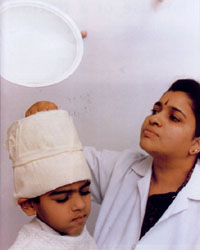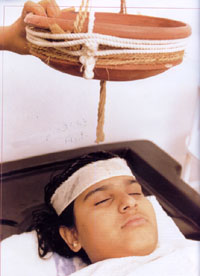The popularity of alternative medicine has lead to renewed interest in the 6,000-year-old practice of ayurvedic medicine.
Zac Sharpe investigated the form of treatment also known as 'the science of longevity'
 As a form of medicine practiced since around 4000 BC, Ayurveda has, at the very least, lived up to its own name. Literally interpreted as the science of longevity, ayurvedic medicine has been a mainstay of Indian life for centuries.
As a form of medicine practiced since around 4000 BC, Ayurveda has, at the very least, lived up to its own name. Literally interpreted as the science of longevity, ayurvedic medicine has been a mainstay of Indian life for centuries.
Revolving around massage and the application and consumption of herbal ointments and medicines, exponents of the ancient discipline boast that it can alleviate symptoms associated with rheumatism, arthritis, migraine, paralysis and almost any other physical ailment.
Widely advertised on the internet and spread word-of-mouth by sub-continent migrants, ayurveda's popularity and acceptance has spread throughout the Middle East and western hemisphere.
Globally, a shift towards natural therapies in general has been taking place over the past decade. Incongruously, much of the impetus towards all things natural and spiritual has been generated by the advancement of technical communication systems.
Many people searching for alternatives to modern medicine and the side affects which are often a consequence of its reliance on chemicals, have turned to alternative medicine. And it is developments such as the internet which have offered eastern philosophies such as ayurveda instant credibility and a wider audience.
Scores of web sites dedicated to ayurveda have been set up in the United Kingdom where the large Indian population has wielded its influence on the British way of life way beyond the introduction of the humble chicken tikka masala.
Mediums such as the internet have offered a certain legitimacy to some forms of alternative medicine which were previously reliant on exotic lore and backpackers' tales.
But despite the increasing number of people turning to ayurveda and its growing stature as a genuine alternative to traditional medicine, governments and insurance companies alike continue to tread cautiously.
In the UAE alternative medicines, including ayurveda and homeopathy, are not officially recognised. Centres such as the Home of Ayurveda in Dubai are able to provide herbal massage while striving for the formal recognition afforded the other branches of medical science.
The herbal massage treatment forms an integral part of the practitioner's repertoire in dealing with illness and injury. However, other methods such as the supplying of oral medicines are strictly prohibited under UAE law and omitted from the local ayurveda clinics' range of services.
Miracle Cure
Dr Moly Joses from Home of Ayurveda is one of a handful of qualified ayurvedic doctors operating in the UAE. Five years of study were undertaken before she received her bachelor degree from a Kerala university.
Part of the studies require students to memorise scores of ancient Sanskrit poems which recite the litany of ingredients comprising the thousands of healing balms, oils, lotions and pastes.
While Dr Joses' clinic is restricted to women only, a recent accident meant this writer had a more than academic interest in ayurveda's approach to a vast catalogue of injuries. Broken arms, knees and collarbones, all the subject of regular and arduous physiotherapy treatment, could each be dealt with by the ayurvedic surgeon, according to Dr Joses.
So a few recommendations were made with the promise of noticeable improvement within two weeks. Both the time frame and method sounded more alluring than the rigours of six months on the physio's couch.
 "To reduce swelling around the broken arm we first apply 'kizha', or medicated balls," said Dr Joses.
"To reduce swelling around the broken arm we first apply 'kizha', or medicated balls," said Dr Joses.
Contained in a palm-sized sack, the balls and a powder made from roots and herbs are gently padded onto the damaged limb over the course of one hour.
"This technique is also a successful way of treating polio and degenerative conditions."
"After a couple of weeks we could move onto massage with a lotion containing three or four herbal ingredients and a ghee vegetable base," explained Dr Joses.
The third and final stage a week later promised more relaxing massage, but this time of a slightly more rigorous nature with the added allure of hot oils or 'pizhichil'.
"This type of massage has helped some elderly local women we treat to rejuvenate their muscles to the point where they can tentatively walk again after several years restricted to bed or a wheelchair," said Dr Joses.
Sceptics
Before abandoning western medicine altogether I consulted my regular physiotherapist on the merits of alternative medicines in the treatment of broken and damaged body parts. Rather surprisingly, I was not dissuaded to pursue complementary avenues of treatment.
"A lot of the scepticism expressed by western scientists towards alternative approaches such as ayurveda and homeopathy has wavered over the past five or ten years," she said.
"In fact, you only have to go back about 15 years to a time when physiotherapy was itself viewed with a fair amount of skepticism. Given it is now a standard part of post-operative treatment, who is to say how alternative treatments and approaches will be viewed in the future".
Much of the benefits of ayurveda stem from its relaxing massage techniques. Dr Joses said there was more demand from people looking for stress relief and relaxation at her clinic than a cure for any particular ailment.
"In the UAE we are not licenced to operate a medical facility so we concentrate on the other benefits ayurveda has to offer in counter-balancing the stressful urban lifestyle," said Dr Joses.
Dubai-based writer Runesh Menon, however, is one local advocate of the healing powers of ayurveda. He had spent months battling to overcome troublesome abdominal pains after a supposedly uncomplicated hernia operation.
"I only resorted to ayurveda after regular consultations with my usual doctor proved fruitless," said Menon.
"At home in India there had always been some basic ayurvedic medicines lurking in the bathroom cabinet but I had never really given it much credence beyond the odd cold or upset stomach."
"But, ironically enough, it was an Arab friend of mine who suggested I try it after he had been encouraged by the results a work colleague had had success treating arthritic fingers," he explained.
Menon, and indeed ayurvedic specialists themselves, did not promise a quick fix solution from the alternative therapy but did claim that the improvement was marked within two months of starting once-a-week massage sessions.
"Patience is definitely part of the process. Some people I have spoken to who know little about ayurveda thought it may be some sort of instant faith healing type of fallacy. But its roots are firmly planted in science."
And a complicated science it would seem to be.
Unlike Swedish or manipulative massage techniques, the massuers who administer this ancient Indian version place greater emphasis on the ingredients used in the applied lotions than in actual massage technique.
To the layman familiar with no more than cooking favourites like oregano or paprika, the inventory of herbs on offer to the qualified ayurvedic surgeon is almost incomprehensible. Suffice to say, those hoping to remedy their ailments by rummaging through the spice rack for some morsels to rub into the skin would be barking up the wrong root.
The sanskrit ayurveda manuals which have evolved over centuries contain literally thousands of ingredients, a mixture of which can go into formulating any single treatment.
The bulk of ayurvedic products are manufactured from roots, stock, flowers, skins and leaves sourced from the lush foothills of the Himalayan ranges.
If further evidence of the technical nature of the herbal science were needed, a perusal of the ingredient list Dr Joses had prescribed her last four patients would allay doubts.
A few of the botanical names of the plants making the top ten in one day included :
1. Alpaenia calcarata 2. Rhizinus communis 3. Sida rhetusa 4. Strabilanthaus kunthiyanus 5. Asparagus rasimosis 6. Dragiya involuecratta 7. Adathoda vasika 8. Tibospora cordifolia 9. Sedar 10. Acconitum hettarofillam.
As well as the science, there is the underlying belief in the importance of spirituality as a route to healing.
Dr Vasant Lal, an expert in the field for almost 20 years, explained that five earthly factors make up the ethereal whole in ayurvedic philosophy.
"Space, air, fire, water and earth tie in with the five motor organs of speech, hands, feet, genitals and organs of excretion," Dr Lal said.
According to ayurveda, every person is a creation of the cosmos , the pure cosmic consciousness, as two energies; male energy called Purusha and female energy called Prakruti. All are influenced by three basic universal qualities which further manifest......
And so on. As for this battered and bruised writer, I can only attest that the massage is at the very least relaxing. And I'll leave the philosophy in the hands of the experts because it only serves to fuel my Tamas which tends towards inertia and deep sleep.